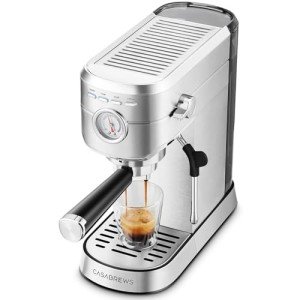Heat Exchange Espresso Machines: A Comprehensive Guide
Espresso machines have evolved significantly for many years, catering to the requirements of home baristas and coffee professionals alike. Amongst these machines, heat exchange espresso machines have actually gotten appeal due to their ability to deliver constant performance and exceptional brew quality. In this post, we will explore the workings, benefits, and essential features of heat exchange espresso machines, supplying an extensive understanding for both potential purchasers and coffee enthusiasts.
Understanding Heat Exchange Technology
Heat exchange espresso machines run on a distinct principle that allows synchronised water heating for brewing and steaming. They are equipped with a single boiler that uses a heat exchanger system. This function is considerable as it allows users to brew espresso while steaming milk simultaneously, promoting efficiency in the coffee-making process.
How Does a Heat Exchange Espresso Machine Work?
The process begins with the machine's water inlet filling the boiler. As the water warms up, it turns to steam. The ingenious heat exchanger uses hot steam to heat extra water in a different passage developed specifically for the brew group. This implies that water can reach the ideal developing temperature without waiting for the boiler to change. The essential actions consist of:
- Water Fill: Water is drawn into the boiler.
- Heating Process: The boiler warms up as water is transformed into steam.
- Heat Exchange: Steam warms water in the heat exchanger tube.
- Brewing: Water from the heat exchanger is pushed through coffee grounds, drawing out the tastes required for a rich espresso.
This procedure enables fast temperature adjustments and enhanced coffee extraction.
Advantages of Heat Exchange Espresso Machines
Heat exchange espresso machines offer several advantages, especially for those wanting to optimize their coffee experience. Here are some essential advantages:
- Simultaneous Brewing and Steaming: Users can brew espresso while steaming milk, making it ideal for hectic cafes and home baristas who value performance.
- Temperature Stability: The boiler's steam pressure helps preserve a stable temperature level, which is crucial for consistent espresso extraction.
- Flexibility: The design enables fast changing between developing and steaming, making it easier to produce numerous coffee beverages, from lattes to coffees.
- User-friendly: Models typically feature accessible controls, making it possible for both novices and skilled baristas to produce quality beverages.
- Professional Quality: Heat exchange machines are typically used in commercial settings, providing users with high-quality brewing efficiency in your home.
Secret Features to Look for in Heat Exchange Espresso Machines
When considering the purchase of a heat exchange espresso machine, there are numerous features that a person ought to consider:
- Build Quality: Look for machines made from durable products, such as stainless steel or brass, making sure durability.
- Boiler Size: A larger boiler will hold more water and sustain higher output with time.
- PID Temperature Control: This function assists keep consistent brew temperature levels, which can enhance the coffee-making process.
- Group Head Design: Machines with a saturated or semi-saturated group head provide much better temperature stability.
- Relieve of Use: User-friendly interfaces and instinctive controls enhance the total experience for baristas at all ability levels.
- Steam Wand Quality: A good steam wand with correct insulation and flexibility allows for much better texturing of milk.
- Water Reservoir Size: Depending on your needs, consider how often you desire to refill the water tank.
Contrast of Popular Heat Exchange Espresso Machines
To better understand the options offered in the market, below is a comparison table of some popular heat exchange espresso machines:
| Machine Model | Boiler Size | PID Control | Price Range | User Ratings |
|---|---|---|---|---|
| Profitec Pro 700 | 2.0 L | Yes | ₤ 2,000-₤ 2,500 | 9.5/ 10 |
| Rocket Espresso R58 | 1.8 L | Yes | ₤ 2,400-₤ 2,800 | 9.4/ 10 |
| Elekta Bianca | 1.8 L | Yes | ₤ 2,500-₤ 3,000 | 9.6/ 10 |
| La Spaziale S1 Vivaldi II | 1.5 L | Yes | ₤ 1,800-₤ 2,200 | 9.2/ 10 |
| Bezzera Magica | 1.2 L | No | ₤ 1,600-₤ 1,800 | 9.0/ 10 |
Frequently Asked Questions About Heat Exchange Espresso Machines
What is the primary distinction between a heat exchange and a dual boiler espresso machine?
While both types can brew espresso and steam milk at the very same time, dual boiler machines have different boilers for developing and steaming. In contrast, heat exchange machines use a single boiler and a heat exchanger to accomplish the exact same function.
Are heat exchange machines suitable for novices?
Yes! Office Espresso Machines of heat exchange machines are developed with easy to use features, making them accessible for newbies. With proper guidance and practice, users can quickly produce quality espresso.
What sort of upkeep do heat exchange espresso machines require?
Routine maintenance includes descaling, cleaning the boiler, checking seals and gaskets, and keeping the group head tidy. Office Espresso Machines guarantees durability and consistent efficiency.
Can I use a heat exchange machine for different types of coffee beverages?
Absolutely! Heat exchange machines permit users to create a range of coffee beverages, including espresso, lattes, cappuccinos, and more.
Heat exchange espresso machines represent a blend of development and custom, providing coffee lovers with the tools needed for crafting the best cup. Their ability to concurrently brew and steam, integrated with precise temperature level control, makes them an engaging option for both home baristas and professionals. With the right understanding on features and maintenance, users can unlock a world of charming coffee experiences, making sure that each sip is as wonderful as the last.

